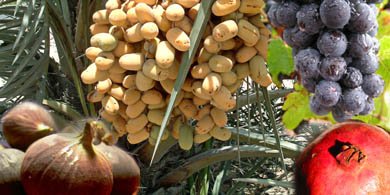"Is Man a Tree of the Field?"
Tu BiShvat, "the New Year of the Trees,"[1] has its own customs,[2] which our Rabbis[3] associate with the phrase,[4] "Is man a tree of the field?" Because the tree-metaphor is so fundamental to our divine service, we celebrate the New Year of the Trees. 
A tree may be divided into three parts: (a) roots; (b) trunk, branches and leaves; and (c) fruit. Though the roots of a tree are not visible, they serve two vital functions: they support the tree, enabling it to withstand strong winds, and they deliver most of its nourishment. The trunk, branches and leaves constitute the bulk of the tree's body, reflect its growth, and make the tree attractive to the onlooker - but they are not its ultimate purpose. It is the fruit[5] that benefits others and contains the seeds which bear the species' promise for posterity.
These components of the tree symbolize aspects of our personalities. The roots represent faith, the spiritual quality which connects man to G-d, the source of his nourishment. As a person develops spiritually, he learns to rely on his strong foundations of faith for support.
The trunk, branches and leaves represent our study of Torah, observance of the mitzvos, and the expression of Jewish values in our daily conduct. These enable a person to develop himself and they generate an inner beauty which makes him attractive to others.
The ultimate fulfillment of a person, however, is his fruits. These are his involvements - first with his own family, the seeds he has planted, but also with the people around him. Through his efforts to become involved with others, one tree can bring another into being. For example, a person might inspire a colleague to emulate his example and establish a foundation of faith, grow in the study of Torah and the observance of mitzvos, and ultimately take his turn at reaching out to others with sincere concern.
Constant Growth
Men and trees are linked by more than merely structural parallels. The Hebrew word describing the plant kingdom, Tzomeiach, also means "growth". On one hand, this name reflects a deficiency; it is given to the plant kingdom, because growth is one of the few signs of life that plants exhibit. On the other hand, there is something unique about the growth of plants. As opposed to animals or humans, whose physical growth ceases at a particular age, plants continually grow; their life and growth are intrinsically related. This is particularly true of trees, which rise heavenward to great heights.
This should likewise be true of us. Though our physical growth may cease, we should strive to continue growing intellectually and spiritually, never ceasing to develop.
Rooted in the Source
Though a plant continually grows upward, in contrast to animals and humans, which move freely, it must remain firmly rooted in its source of nourishment, the earth.[6] As a Jew is continually growing, he too must remain connected to his roots, his Torah heritage. Most people need to spend most of their time in occupations and concerns that are beyond the immediate sphere of Torah. Under these circumstances, we can only flourish if our faith keeps us firmly rooted to our Torah heritage.
Furthermore, unlike other plants, trees not only remain alive throughout the year and endure its changes of climate, but they continue to grow. This quality can teach us to endeavor to see every situation as potentially contributing to our growth. We need to develop the flexibility and the resilience that enable us to respond positively to change.
As Seedlings Grow and Thrive
Tu BiShvat, like other Jewish holidays, has a special meaning for children, who fulfill the custom of eating Tu BiShvat fruits with gusto. The connection between Tu BiShvat and children brings to mind another lesson applicable to our lives. Just as a small improvement in a seedling produces a greatly improved tree, so too, a small improvement in a child's education can affect him throughout his entire life thereafter.
Our prophets use the metaphor of trees to describe the Jewish people in their ultimate state of fulfillment, the Era of the Redemption:[7] "In days to come, Yaakov will take root; Yisrael will blossom and bud, and will cover the face of the earth with fruit." The coming of Mashiach[8] is described similarly: "A shoot shall emerge from the stem of Yishai, and a branch shall grow out from his roots." May these prophecies be fulfilled in the immediate future.
Notes:
1. Rosh HaShanah 1:1; Shulchan Aruch, Orach Chayim 131:6.
2. Magen Avraham 131:16; see also Pri Etz Hadar, which mentions several Kabbalistic customs associated with this date.
3. Likkutei Maharich, Vol. III, Minhagei Shvat.
4. Devarim 20:19.
5. The centrality of a tree's the fruit is indicated by the way the Torah records the creation of the trees (Bereishis 1:11): "Let the earth give forth... fruit trees, that produce their own species of fruit."
6. Though a fish must also remain continually connected to its source of nourishment (the water), its entire body must remain inseparably in its source. A plant, by contrast, emerges from its source and grows above the earth while maintaining a constant bond with it.
7. Yeshayahu 27:6.
8. Ibid. 11:1.
|
